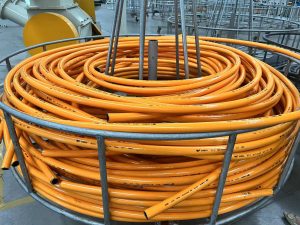Mud rubber hoses play a crucial role in various industrial applications that involve the transportation of abrasive slurries, mud, and other materials. These hoses are specifically designed to handle the challenging conditions encountered in mining, construction, and drilling operations. This article will explore the key features and applications of mud rubber hoses, emphasizing their significance in ensuring efficient and reliable material transfer.
Mud rubber hoses are durable and flexible tubes designed to withstand the abrasive nature of the materials they transport. These hoses are typically constructed using high-quality synthetic rubber compounds that offer excellent resistance to abrasion, corrosion, and impact. The inner lining of the hose is specifically designed to minimize material buildup and reduce frictional losses during transportation.
Handling abrasive materials
Mud rubber hoses are engineered to handle a wide range of abrasive materials, including mud, slurry, cement, and other granular substances. The inner lining of these hoses is typically made of highly abrasion-resistant materials, such as natural rubber or synthetic compounds like SBR (styrene-butadiene rubber). This lining protects the hose from wear and tear caused by the abrasive particles, ensuring efficient and uninterrupted material transfer.

Reinforcement and flexibility
Mud rubber hoses are reinforced with layers of high-strength textile fabrics or steel wire braids to enhance their structural integrity. The reinforcement layers provide resistance against bursting and help the hose maintain its shape under high pressure. Additionally, these reinforcement layers ensure flexibility, allowing the hoses to bend and adapt to the complex and dynamic movements often encountered in industrial applications.
Safety features and maintenance
Mud rubber hoses are equipped with safety features to prevent accidents and protect personnel and equipment. Some hoses are color-coded to indicate their intended use and working pressure limits. Anti-static properties are often incorporated into the hoses to dissipate any static electricity that may build up during material transfer, reducing the risk of electric shocks or sparks.
Regular inspection and maintenance are essential to ensure the longevity and reliability of mud rubber hoses. Visual inspections should be conducted to check for signs of wear, cracks, or leaks. Proper handling, storage, and routine maintenance procedures, such as cleaning and testing, should be followed to ensure optimal performance and prevent unexpected failures.
Mud rubber hoses play a critical role in industrial applications that involve the transportation of abrasive materials. With their durable construction, abrasion-resistant linings, and reinforcement layers, these hoses ensure efficient and reliable material transfer. By incorporating safety features and following regular maintenance practices, industrial facilities can maximize the lifespan and performance of mud rubber hoses while promoting operational safety.